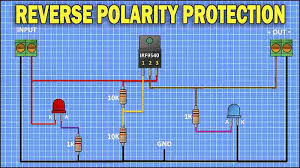
Protecting a Circuit from Reverse Polarity
When it comes to protecting a circuit from reverse polarity, there are several important steps that you can take to ensure the safety and longevity of your electronic devices. Reverse polarity occurs when the positive and negative connections of a circuit are switched, leading to potential damage or even failure of the circuit components.
Fortunately, there are several simple yet effective methods that you can employ to prevent reverse polarity and safeguard your circuit. In this article, we will explore some of the best practices for protecting a circuit from the dangers of reverse polarity.
1. Use Reverse Polarity Protection Components
One of the most common and effective ways to protect a circuit from reverse polarity is to use dedicated protection components such as diodes, fuses, or reverse polarity protection ICs. These components are designed to prevent the flow of current in the wrong direction, thus protecting your circuit from damage.
Diodes, for example, are often used as a simple and cost-effective solution for reverse polarity protection. By placing a diode in series with the positive supply line, you can ensure that current only flows in the correct direction, preventing any potential damage to your circuit.
2. Implement Reverse Polarity Protection Circuits
In addition to using protection components, you can also implement dedicated reverse polarity protection circuits in your design. These circuits are specifically designed to detect and correct reverse polarity conditions, ensuring that your circuit remains safe and operational.
One common type of reverse polarity protection circuit is the MOSFET-based circuit, which uses a MOSFET transistor to control the flow of current based on the polarity of the input voltage. By carefully designing and implementing such a circuit, you can effectively protect your circuit from the dangers of reverse polarity.
3. Label and Color-Code Your Connections
Another simple yet effective way to prevent reverse polarity is to label and color-code your circuit connections. By clearly marking the positive and negative terminals of your circuit, you can reduce the chances of accidental reverse polarity connections.
Using color-coded wires or labels can help ensure that users or technicians can easily identify the correct polarity of the connections, minimizing the risk of damage to the circuit. This simple step can go a long way in preventing costly mistakes and ensuring the longevity of your electronic devices.
4. Perform Regular Checks and Testing
Finally, it is important to regularly check and test your circuit for any signs of reverse polarity or other potential issues. By conducting routine inspections and tests, you can quickly identify and address any problems before they escalate into serious issues.
Performing simple continuity tests or voltage checks can help you ensure that your circuit is functioning correctly and has not been affected by reverse polarity. By staying proactive and vigilant, you can maintain the integrity and reliability of your circuit over time.
Conclusion
Protecting a circuit from reverse polarity is crucial for ensuring the safety and performance of your electronic devices. By using protection components, implementing dedicated circuits, labeling connections, and performing regular checks, you can effectively prevent reverse polarity issues and keep your circuit running smoothly.
Remember to always follow best practices and safety guidelines when working with electronic circuits to avoid any potential hazards. With the right precautions and preventive measures in place, you can enjoy a reliable and long-lasting circuit that meets your needs and expectations.
Was this helpful?
0 / 0